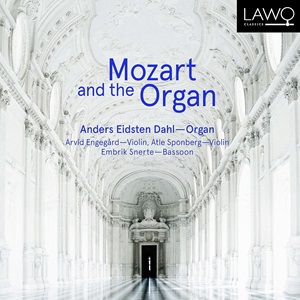
Wolfgang Amadeus Mozart (1756-1791)
Mozart and the Organ
Anders Eidsten Dahl (organ), Arvid Engegår, Atle Sponberg (violin), Embrik Snerte (bassoon)
rec. 2019, Margaretakyrkan, The Swedish Church, Oslo; 2022, Bragernes Church, Drammen, Norway
Lawo Classics LWC1257 [75]
Mozart apparently enjoyed playing the organ and would try out any instrument he came across. However, he probably improvised and he wrote very little composed music for it. The bulk of his contribution to the repertoire is the set of seventeen epistle sonatas he wrote as part of his employment by Archbishop Colloredo in Salzburg, when Mozart was still young. He began writing them in his teens and wrote the last in his early twenties. These epistle sonatas were written for performance during Mass, between the reading of the epistle and that of the gospel, replacing the usual gradual chant. In time the gradual was reinstated, and epistle sonatas were no longer required, so Mozart wrote no more of them.
Archbishop Colloredo’s priority for the liturgy was that it should be celebrated as rapidly as possible, and certainly not take more than three quarters of an hour. Consequently, these epistle sonatas are all short, miniature sonata movements taking not more than about three minutes, though the final two are slightly longer. They are nearly all scored for two violins, bass and organ. In these performances, the bass is provided by a bassoon; it has only a supporting role. In most of them, Mozart treats the organ as a continuo instrument. But in two of them, K. 244 and 245 he gives the organ its own independent part and in the final one, K. 336, the organ part is of a concertante nature. Three of them, K. 241, 278 and 329, are not included here. That leaves room for the three significant works he composed towards the end of his life, originally for a mechanical organ fitted inside a clock, but nowadays played on a normal instrument.
At this stage of his career, Mozart made no distinction in idiom between the music he wrote for the church and what he wrote for secular use. So these epistle sonatas are in a similar style to that of his early masses, which Stravinsky once called rococo sweets of sin. They are charming, elegant, beautifully written and make no claims to depth or profundity, despite their purpose. Going through them in chronological order, as we have here, we can hear Mozart gradually extending his range. K. 144 first strikes a more serious note in its development section. K. 145 is the first to use triple time, K. 241 turns to the minor in the development section, if only for a few bars. By the time we reach K 224 we are in a similar world to that of the lovely A major symphony, K.201. From K. 224 the organ is given some solo work. K. 245 seems to anticipate the opera Idomeneo, and the final K. 336 is almost a small organ concerto, though I think that the keyboard part would sound even better on the piano.
The late works which conclude the recital are in an entirely different world. Even though Mozart chafed under the commission, two of them, K. 594 and 608, are splendid and imposing works. The opening Adagio of K. 594 is expressive and chromatic, and the closing Adagio is even more intense. The intervening Allegro is grand. K. 608 is a work of comparable quality, with a dotted-rhythm opening and a fugue leading to a set of variations. In comparison, K. 616 is lighter, an Andante with two main themes, in the chastened manner of Die Zauberflöte.
The performances of the epistle sonatas are stylish, enthusiastic and idiomatic, not trying to inflate the music but enjoying its verve and charm. The late pieces are also well played, but I felt unease in hearing them. Although they were written for an organ of some kind, I actually don’t think they sound well on the instrument. This is not a criticism of the performances. I think that by this stage in his career, Mozart was so used to the piano as the main vehicle for his keyboard thoughts that the different touch and tone quality of the organ does not suit the musical material. I put on the transcriptions of K. 594 and K. 608 in their piano duet versions, in the performances from the Mozart piano duet recital by Imogen Cooper and Anne Queffélec. Even though the transcriptions are not by Mozart, I felt at once that this was the sound that suited them.
There are several other recordings of the epistle sonatas, mostly of all seventeen, with no room for anything else. There are also several recordings of the late organ works, but differently coupled. However, if you want an overview of what Mozart did with the organ, this will serve you well.
Stephen Barber
Previous review: Glyn Pursglove (November 2023)
Help us financially by purchasing from



Contents:
Church (Epistle) Sonata in E-flat major, K.67/4H (1772)
Church (Epistle) Sonata in B-flat major, K.68/41i (1772)
Church (Epistle) Sonata in D major, K.69/41k (1772)
Church (Epistle) Sonata in D major, K.144/124a (1774)
Church (Epistle) Sonata in F major, K.145/124b (1774)
Church (Epistle) Sonata in B-flat major, K.212 (1775)
Church (Epistle) Sonata in G major, K.241 (1776)
Church (Epistle) Sonata in F major, K.224/241a (1776)
Church (Epistle) Sonata in A major, K.225/241b (1776?)
Church (Epistle) Sonata in F major, K.244 (1776)
Church (Epistle) Sonata in D major, K.245 (1776)
Church (Epistle) Sonata in G major, K.274/271d (1777)
Church (Epistle) Sonata in C major, K.328/317c (1779)
Church (Epistle) Sonata in C major, K.336/336d (1780)
Adagio and Allegro in F minor, K.594 (1790)
Fantasia in F minor, K.608 (1791)
Andante in F major, K.616 (1791)

















